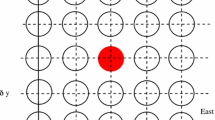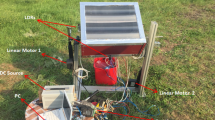Abstract
Scheffler dish solar concentrating systems are used in cooking or process heating applications requiring temperature up to 300 °C. These concentrators are generally equipped with tracking facility to track the sun’s path throughout the day to obtain direct beam radiation. The tracking system helps in achieving the effective operation of the system by concentrating the direct beam radiation at a focal point of the receiver. Currently, in Scheffler dish solar concentrating systems, single-axis tracking, i.e., East–West (E–W) is achieved using timer device while tilting axis, i.e., North–South (N–S) is achieved by adjusting the bars manually. The timer device is either pendulum regulated mechanical system or expensive and intricate electronic timer circuit. A simple and economically viable electronic control for Scheffler dish concentrating systems is highly desired. This paper discusses a simplified and cost-effective circuit design to achieve dual-axis tracking (both E–W and N–S) for easy and effective operation of Scheffler dish concentrator.
Access provided by CONRICYT-eBooks. Download conference paper PDF
Similar content being viewed by others
Keywords
- Dual-axis Tracking
- Direct Beam Radiation
- Reduction Gear Ratio
- Solar Tracking System
- Semicircular Structure
These keywords were added by machine and not by the authors. This process is experimental and the keywords may be updated as the learning algorithm improves.
1 Introduction
Dual-axis tracking system is essential for concentrating solar power (CSP) technologies such as Scheffler dish to harness maximum solar energy by tracking daily and seasonal variations of solar positions. The commercially available electro-optical trackers are accurate but expensive due to intricate design and sophisticated fabrication needs.
Barsoum [1] used a chain drive with 4:1 gear reduction ratio between motor socket and frame socket, Khan et al. [2] developed a tracking system with 150° total angle of rotation (east to west) with 3.75° rotation of stepper motor for every 15 min and Saravanan et al. [3] integrated a three-phase 0.5 HP induction motor to their solar tracking system with gear reduction ratio of 25:1, where we used a gear reduction drive of 30:1 ratio to achieve smooth and controlled tracking. Abdul-lateef et al. [4] developed a single-axis tracker prototype with PIC16F84A flash microcontroller and 9 V permanent magnet geared DC motor of lower capacity for lighter loads, Kansal [5] developed a single-axis sun tracking system using PIC microcontroller and stepper motors and achieved 8% tracking efficiency at field conditions.
In our work we employ inexpensive DC wiper motor that has the capability to withstand higher loads. Further, in contrast to Patil et al. [6] we are using a low-cost timer circuit.
2 Experimental Setup
The Scheffler dish concentrator system consists of a reflector and receiver. The reflector forms a lateral section of a paraboloid and the receiver is placed at its focal point. In our setup, for reflector we used polished aluminium sheets which were firmly inserted between aluminium sections along with rigid frame and stand made of mild steel. Boiler grade mild steel tank with black-coated face was used as receiver. The face of the receiver absorbs the concentrated rays from the reflector and transfer the heat energy to the water in the tank to produce steam. The saturated steam at desired pressure is obtained using a resettable pressure release valve. Two linear actuators were fitted with the receiver to achieve seasonal tracking. The schematic of the Scheffler dish concentrator is shown in Fig. 1.
3 Design and Development of Tracking System
3.1 East–West Tracking Control
The semicircular structure of the Scheffler dish is used for achieving smooth and controlled tracking. A chain slides over the semicircular structure. A compound gear reduction drive is connected between the DC motor and the chain through sprocket. The operation of DC motor is controlled by the timer control circuit.
The control circuit for E–W tracking comprises step-down transformer (230 V AC–12 V AC supply), rectifier (12 V AC–12 V DC), DC voltage regulator (for constant 5 V DC), PIC 16F876 micro controller, LED display, LED indicators, relays, and control switches. An AC-to-DC adaptor of 12 V, 5 A is used to supply power to the low-cost motor.
The schematic block diagram of the E–W solar tracking system is shown in Fig. 2. The design features of the tracking system are as follows.
A PIC microcontroller and other electronic components used in the control unit were procured locally. A compound gear reduction drive having gear reduction ratio of 30:1 was procured from a local supplier. The program was written in PICBASIC. The program code is compiled and assembled using PB-PLUS compiler. The usage of battery was eliminated by using an AC-to-DC adaptor. A simple circuit with fewer electronic components and single-layer PCB design has been developed using Proteus Design Suite. The circuit diagram is shown in Fig. 3.
The DC motor is connected to the output pin 7 of the microcontroller. Push buttons S2 and S3 are used for ON time increments and ON time decrements. Push buttons S4 and S5 are used for OFF time increments and OFF time decrements. Push buttons S5 and S1 are used to start ON–OFF cycle and to reset ON–Off cycle. The ON–Off cycle should be set accordingly to achieve 15° angle of rotation per hour. The cycle continues throughout the day to achieve E–W tracking.
3.2 North–South Tracking Control
The circuit design for north–south control of the Scheffler dish was developed, as shown in Fig. 4.
The circuit design was simulated and tested in Proteus for the control operation. P1 and P2 are used for controlling the relays R1 and R2, respectively. Switches 1–5 are used for achieving different control configurations of the motors M1 and M2 when P1 and P2 are activated. After fabrication of the circuit in PCB, the circuit will be connected to two linear actuators of 24 V and 4 A rated capacity to achieve the seasonal adjustment (N–S tracking).
4 Simulation Results and Discussion
The simulation of the designed E–W and N–S circuits were carried out in Proteus simulation tool. The working of the E–W control circuit was verified by connecting the 7th pin (RA5) of the microcontroller to a NO (normally open) relay RL having excitation coil voltage of 5 V, 10 A maximum allowable current at contact terminal and connecting the 12 V DC motor through the relay contact (Fig. 5).
The program for the cyclic timing operation was fed into the microcontroller. The ON and OFF cycle operation of the relay was tested with a sample timing cycle of 5 s ON and 30 s OFF. It was found that the relay operated in accordance with the ON–OFF cycle. In Fig. 6, the blue line peeks indicate the ON cycle voltage at relay contact. Thus, the E–W tracking can be achieved by connecting the supply to the 12 V DC motor through the relay RL. The ON–OFF cycle to achieve 15° E–W angular rotation per hour of the Scheffler dish concentrator is 1 and 74 s respectively.
The working of the N–S control was also verified for different switching configurations. In Fig. 7, the yellow and green line peeks indicate the forward and reverse currents of the motors M1 and M2 when push button P1 is pressed while Fig. 8, the yellow and green line peeks indicate the reverse and forward currents of the motors M1 and M2 when push button P2 is pressed, indicating successful operation of both forward–reverse and reverse–forward rotations.
5 Conclusion
Simulation results indicated that a timer based electronic control circuit can be used to achieve dual-axis tracking (both E–W and N–S) of Scheffler dish concentrator through PIC microcontroller and relays. The circuit design is simple and uses inexpensive components making it a cost-effective choice both in terms of fabrication and maintenance. The future work will include fabrication of circuit on PCB and its comprehensive evaluation.
References
N. Barsoum, Implementation of dual-axis solar tracking pilot project. Trans. Energy Biotechnol. Plann. Environ. ET-E33/GJTO, 2229–8711 (2011)
M.T.A. Khan, S.M. Shahrear Tanzil, R. Rahman, S.M. Shafiul Alam, in Design and Construction of an Automatic Solar Tracking System. 6th International Conference on Electrical and Computer Engineering ICECE (2010)
C. Saravanan, M.A. Panneerselvam, I. William Christopher, A Novel low cost automatic solar tracking system. Int. J. Comput. Appl. 31, 0975–8887 (2011)
K.I. Abdul-lateef, A low cost single-axis sun tracker system using PIC microcontroller. Diyala J. Eng. Sci. 5, 65–78 (2012)
R. Kansal, PIC Based Automatic Solar Radiation Tracker (M. Tech thesis). Thapar University, Patiala, Punjab (2008)
R.J. Patil, G.K. Awari, M.P. Singh, Comparison of performance analysis of Scheffler reflector and model formulation. Int. J. Sci. Technol. 4(10) (2011)
Acknowledgements
The work is funded by Department of Science and Technology, Government of India. The authors sincerely acknowledge Dr. M. Shyam (Director, SPRERI) for his support and guidance. The authors also acknowledge Dr. V. Siva Reddy (Ex-Head of the Department) for initiating the work and providing valuable guidance.
Author information
Authors and Affiliations
Corresponding author
Editor information
Editors and Affiliations
Rights and permissions
Copyright information
© 2018 Springer Nature Singapore Pte Ltd.
About this paper
Cite this paper
Gokul Raj, A., Bollavarapu, A., Dubey, M. (2018). Development of Dual-Axis Tracking Control System for Scheffler Dish Concentrator. In: Chandra, L., Dixit, A. (eds) Concentrated Solar Thermal Energy Technologies. Springer Proceedings in Energy. Springer, Singapore. https://doi.org/10.1007/978-981-10-4576-9_3
Download citation
DOI: https://doi.org/10.1007/978-981-10-4576-9_3
Published:
Publisher Name: Springer, Singapore
Print ISBN: 978-981-10-4575-2
Online ISBN: 978-981-10-4576-9
eBook Packages: EnergyEnergy (R0)












